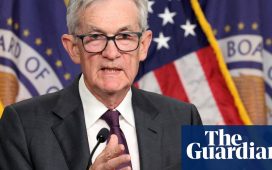Unlock the Editor’s Digest for free
Roula Khalaf, Editor of the FT, selects her favourite stories in this weekly newsletter.
Oops, they did it again. For what feels like the 100th time in the past couple of years — honestly I lose count — investors have embarked on a big rethink on what happens next to global interest rates.
The “higher for longer” mantra on rates went down in flames at the back end of last year. Instead, investors ran in to 2024 with a clear-eyed certainty that rates are going to fall hard and fast. But already, they are now looking at bumper US jobs data and various “steady on there” comments from rate setters and pushing expectations for the first cuts further out in to the future.
So, “um, higher for a bit longer, actually” is the new consensus, with everything this implies for government bonds, continuously soaring stocks, and all the other asset classes in between. It is probably no coincidence that in among all this, niggling worries about the health of the commercial real estate market are starting to bubble up again. As S&P Global Ratings put it late last year: “Higher-for-longer interest rates remain the key risk for real estate assets globally.”
US Treasury secretary Janet Yellen is, reassuringly, on it. “Yes, I do have a concern about commercial real estate,” she said in Congress this week. Yellen pointed to the impact of the higher interest rate environment coupled with many commercial real estate loans coming due that need to be refinanced in a context where vacancy rates are quite high. She said that “is going to put a lot of stress on the owners of those properties”.
Yellen added that she believed the situation to be “manageable”. But some institutions are likely to be “quite stressed”. Given the still recent 2008-09 memory of housing-related woes infecting banks and going on to infect entire economies, that makes investors quite stressed too.
This week, it was the turn of the snappily named European real estate lender Deutsche Pfandbriefbank to provide a reminder of that dynamic. In a statement, it said it was setting aside up to €215mn to cover potential losses in what it called “the greatest real estate crisis since the financial crisis”. That amount represents more than double its pre-tax profits for 2023, which were at the lower end of the expected range. Its bonds took a big hit.
Separately, the real estate driven horror show at New York Community Bancorp continues to rumble on. Having already dropped by half since the end of January, the bank’s share price stumbled lower yet again this week, and Deutsche Bank’s analysts noted this was one reason for US government bonds to gain in price early on Wednesday — a classic hunt-for-safety move. The early equity and bond shifts later unravelled, but it is a sign that wider markets are growing a little spooked.
Broker Liquidnet said it has seen a surge in trading volumes in real estate investment trusts, and also in property-related debt — not just in the speculative part of the market, but also at the more conservative end of the spectrum that is “not used to seeing such volatility”.
At the start of last year, it added, real estate related flows accounted for a single-digit percentage slice of its overall trading, which is focused on illiquid assets. That has now swept up to around 16 per cent of a total that is also growing fast. Not all of this is distressed, but some of the debt is trading at prices as low as 30 cents on the dollar.
For bargain hunters, the distress is a bonus. Blackstone, for instance, ploughed an unusually large 55 per cent of its property investments in to Europe and the UK last year. But the big danger for real estate now is that good news is bad news. Many investors have hoped or assumed that a recession will hit and central bankers will ride to the rescue of leveraged real estate institutions by slashing rates before the borrowers have to roll over debt. But central bankers have spent the opening weeks of this year pushing back at the notion they are in a hurry to cut. It is even worth taking seriously the possibility, however slim, that inflation roars back up and they are forced to raise rates again in response.
“We worry that . . . the recent good news on (diss) inflation may not last, and market expectations could quickly shift from a soft landing scenario to a ‘no landing’ outlook,” said Tiffany Wilding, an economist at bond investment house Pimco in a note this week. Wilding says she still expects the Fed to cut rates by 0.75 percentage points this year. But she acknowledges that policymakers are already nervous enough about persistent inflation and upbeat economic data to guide the market away from anticipating a cut in rates in March.
She also has a slightly ominous warning: “We note that stress in the regional banking sector has resurfaced. While we don’t believe these issues are likely to become systemic, they do emphasise how high rates can create an environment of increased financial stability risks . . . ”
The first rule of financial market accidents is that they never happen where you expect. Otherwise, they would not be accidents. And everyone has “real estate” at the top of their lists of potential accidents. But the constant reminders of stress, from the US, China, Nordics and continental Europe, are starting to put investors on edge.
katie.martin@ft.com









